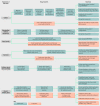Using information technology to improve surveillance of antimicrobial resistance in South East Asia
- PMID: 28874344
- PMCID: PMC5598292
- DOI: 10.1136/bmj.j3781
Using information technology to improve surveillance of antimicrobial resistance in South East Asia
Abstract
Sirenda Vong and colleagues argue that investing in information technology surveillance systems to detect trends is an essential first step in tackling antimicrobial resistance in South East Asian countries
Conflict of interest statement
Competing interests: The authors have read and understood BMJ policy on declaration of interests and declare no competing interests.
Figures

References
-
- World Health Organization. United Nations high-level meeting on antimicrobial resistance. 2016. http://www.who.int/antimicrobial-resistance/events/UNGA-meeting-amr-sept... - PubMed
-
- Antimicrobial Resistance Standing Committee. National surveillance and reporting of antimicrobial resistance and antibiotic usage for human health in Australia. June 2013. https://www.safetyandquality.gov.au/wp-content/uploads/2014/02/National-...
-
- World Health Organization. Global action plan on antimicrobial resistance. 2015. www.who.int/antimicrobial-resistance/publications/global-action-plan/en/ - PubMed
-
- World Health Organization. Global antimicrobial resistance surveillance system: manual for early implementation. 2015. apps.who.int/iris/bitstream/10665/188783/1/9789241549400_eng.pdf
-
- World Bank. Population estimates and projections. 2017. data.worldbank.org/data-catalog/population-projection-tables
Publication types
MeSH terms
Substances
Grants and funding
LinkOut - more resources
Full Text Sources
Other Literature Sources
Medical
